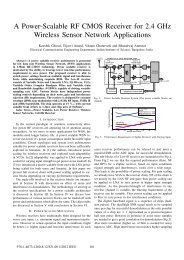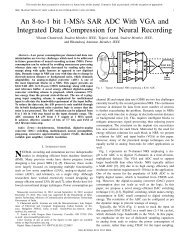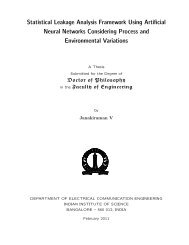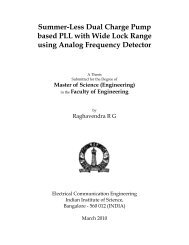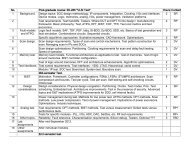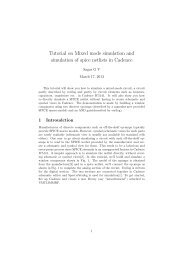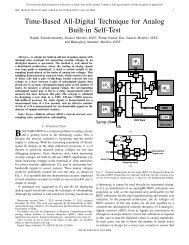NoC design and optimization for Multi-core media processors
NoC design and optimization for Multi-core media processors
NoC design and optimization for Multi-core media processors
Create successful ePaper yourself
Turn your PDF publications into a flip-book with our unique Google optimized e-Paper software.
CHAPTER 2. RELATED WORK 15slot with all of its neighbors [57]. This method will bring down the operating speed of the<strong>NoC</strong> as the slowest router will dictate the speed of the <strong>NoC</strong>. Further, power managementtechniques such as multiple clock domains is not feasible with this approach. AElite[58]<strong>and</strong> dAElite[59] have been proposed as improved next generation Æthereal <strong>NoC</strong>s. AEliteinherits the guaranteed services model from Æthereal. To overcome the global synchronicityproblem, AElite proposes use of asynchronous <strong>and</strong> mesochronous links as a possibility.As noted in the paper[58], using mesochronous links alone may not be sufficient if routers<strong>and</strong> NIs are plesiochronous[60]. One of the drawbacks of AElite was number of slotsoccupied by the header flits. A header flit in AElite occupied one in three slots <strong>and</strong> theoverhead rises to up to 33%. dAElite circumvents the header flit overhead by routingbased on the time of packet injection <strong>and</strong> packet receiving. One of the disadvantages ofdAElite is an increase in the number of link wires, due to the configuration network <strong>and</strong>also because of separate wires <strong>for</strong> end-to-end credit communication.The Octagon <strong>NoC</strong>[34] implements a centralized best fit scheduler to configure <strong>and</strong>manage non-overlapping connections. The scheduler cannot establish a new connectionthrough a port if it is blocked by another connection. This results in increased connectionestablishment time at the routers <strong>and</strong> also packet losses.2.1.3 QoS by Space Division <strong>Multi</strong>plexingAs an alternative to TDM techniques, Spatial Division <strong>Multi</strong>plexing (SDM) techniques<strong>for</strong> QoS have been proposed in [23],[61] <strong>and</strong> [62]. SDM techniques involve sharing fractionof links between connections simultaneously based on b<strong>and</strong>width requirements of thecorresponding connections. An approach comparable to a static version of SDM calledLane-Division-<strong>Multi</strong>plexing has been proposed in [7]. Lane-Division-<strong>Multi</strong>plexing is basedon a reconfigurable circuit switched router composed of a crossbar <strong>and</strong> data converters.Disadvantage of the solution in [7] is that it does not support channel sharing <strong>and</strong> BEtraffic. An additional network is required <strong>for</strong> configuring the switches <strong>and</strong> <strong>for</strong> carryingthe BE traffic. Sharing a subset of wires between connections as in [63] leads to a morecomplex switch <strong>design</strong> with huge delay. SDM <strong>and</strong> TDM techniques have been combined




